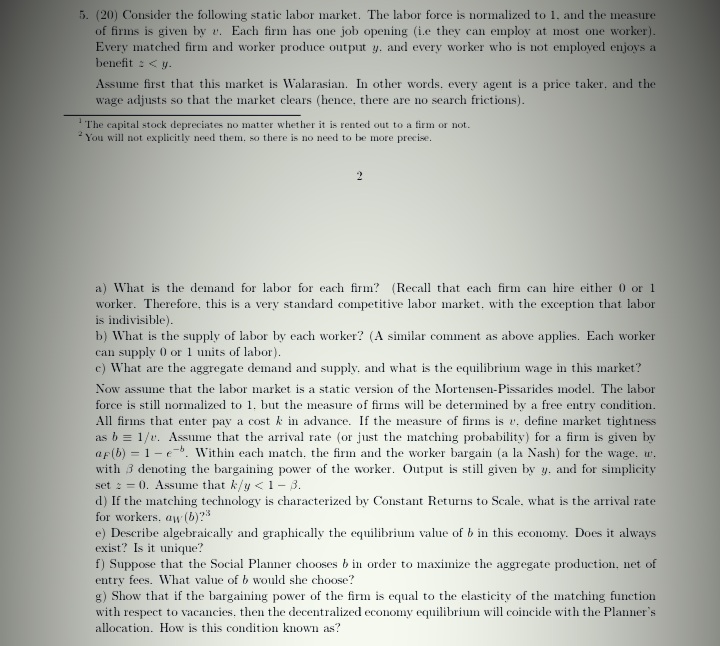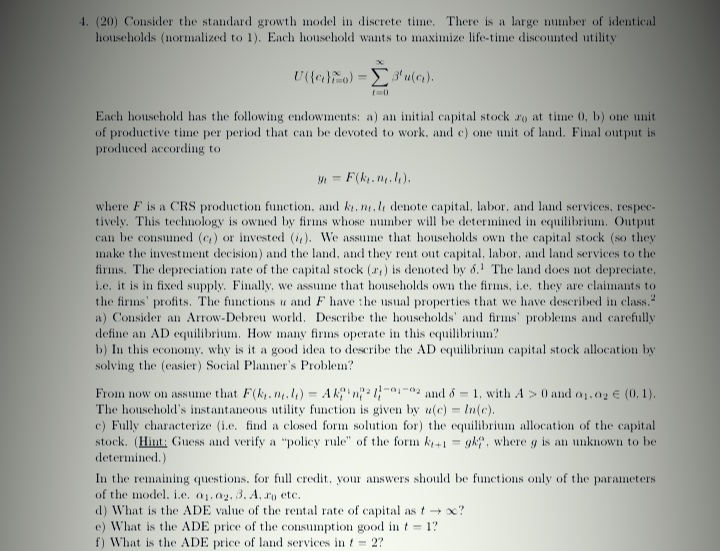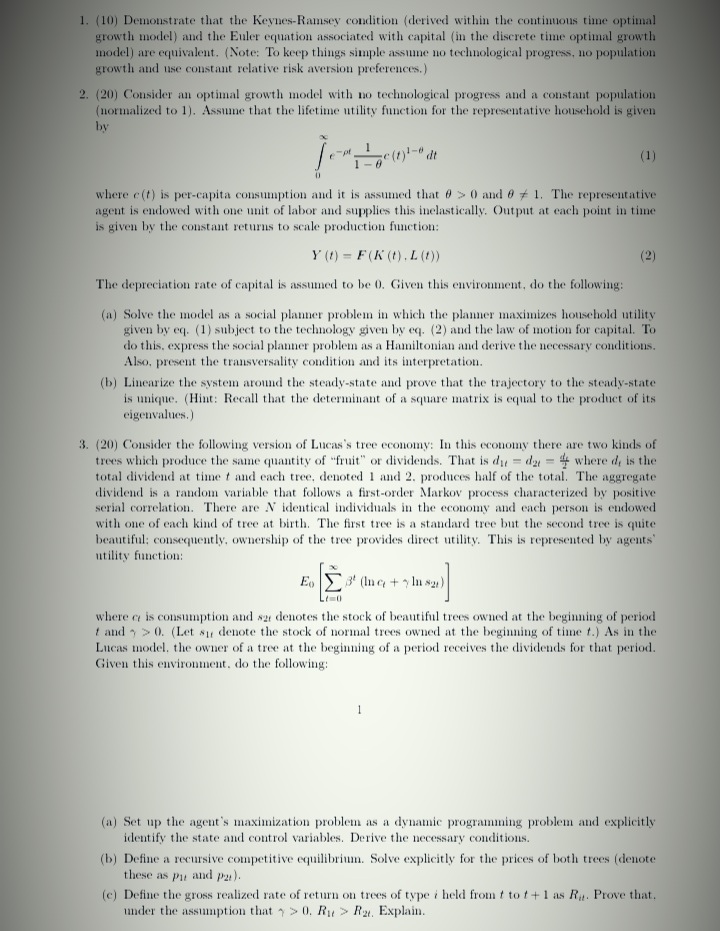


Please help tutors
5. (20) Consider the following static labor market. The labor force is normalized to 1. and the measure of firms is given by v. Each firm has one job opening (ie they can employ at most one worker). Every matched firm and worker produce output y. and every worker who is not employed enjoys a benefit : 5 y. Assume first that this market is Walarasian. In other words. every agent is a price taker, and the wage adjusts so that the market clears (hence, there are no search frictions). The capital stock depreciates no matter whether it is rented out to a firm or not. You will not explicitly need them. so there is no need to be more precise. a) What is the demand for labor for each firm? (Recall that each firm can hire either 0 or 1 worker. Therefore, this is a very standard competitive labor market. with the exception that labor is indivisible). b) What is the supply of labor by each worker? (A similar comment as above applies. Each worker can supply 0 or 1 units of labor). c) What are the aggregate demand and supply. and what is the equilibrium wage in this market? Now assume that the labor market is a static version of the Mortensen-Pissarides model. The labor force is still normalized to 1. but the measure of firms will be determined by a free entry condition. All firms that enter pay a cost & in advance. If the measure of firms is a. define market tightness as b = 1/v. Assume that the arrival rate (or just the matching probability) for a firm is given by ap(b) = 1 -e-. Within each match. the firm and the worker bargain (a la Nash) for the wage, w. with 3 denoting the bargaining power of the worker. Output is still given by y. and for simplicity set : - 0. Assume that k/y 0 and on.age (0. 1). The household's instantaneous utility function is given by u(e) = In(e). e) Fully characterize (i.e. find a closed form solution for) the equilibrium allocation of the capital stock. (Hint: Guess and verify a "policy rule" of the form bet = got, where y is an unknown to be determined.) In the remaining questions. for full credit, your answers should be functions only of the parameters of the model. i.e. m.02. 3. A, ro etc. d) What is the ADE value of the rental rate of capital as f - ? e) What is the ADE price of the consumption good in f = 1? f) What is the ADE price of land services in / = 2?1. (10) Demonstrate that the Keynes-Ramsey condition (derived within the continuous time optimal growth model) and the Euler equation associated with capital (in the discrete time optimal growth model) are equivalent. (Note: To keep things simple assume no technological progress, no population growth and use constant relative risk aversion preferences. ) 2. (20) Consider an optimal growth model with no technological progress and a constant population (normalized to 1). Assume that the lifetime utility function for the representative household is given by (1) where e(f) is per-capita consumption and it is assumed that o > 0 and 8 # 1. The representative agent is endowed with one unit of labor and supplies this inelastically. Output at each point in time is given by the constant returns to scale production function: Y (1) = F( K (1). L() (2) The depreciation rate of capital is assumed to be 0. Given this environment, do the following: (a) Solve the model as a social planner problem in which the planner maximizes household utility given by eq. (1) subject to the technology given by eq. (2) and the law of motion for capital. To do this, express the social planner problem as a Hamiltonian and derive the necessary conditions. Also, present the transversality condition and its interpretation. (b) Linearize the system around the steady-state and prove that the trajectory to the steady-state is unique. (Hint: Recall that the determinant of a square matrix is equal to the product of its eigenvalues.) 3. (20) Consider the following version of Lucas's tree economy: In this economy there are two kinds of trees which produce the same quantity of "fruit" or dividends. That is du = de = 4 where do is the total dividend at time f and each tree, denoted 1 and 2. produces half of the total. The aggregate dividend is a random variable that follows a first-order Markov process characterized by positive serial correlation. There are N identical individuals in the economy and each person is endowed with one of each kind of tree at birth. The first tree is a standard tree but the second tree is quite beautiful: consequently, ownership of the tree provides direct utility. This is represented by agents' utility function: Eo where or is consumption and sa denotes the stock of beautiful trees owned at the beginning of period " and - > 0. (Let su denote the stock of normal trees owned at the beginning of time t.) As in the Lucas model, the owner of a tree at the beginning of a period receives the dividends for that period. Given this environment. do the following: (a) Set up the agent's maximization problem as a dynamic programming problem and explicitly identify the state and control variables. Derive the necessary conditions. (b) Define a recursive competitive equilibrium. Solve explicitly for the prices of both trees (denote these as pu and pa). (e) Define the gross realized rate of return on trees of type i held from f to f + 1 as Ra. Prove that. under the assumption that 4 2 0. Ru > Ry. Explain












